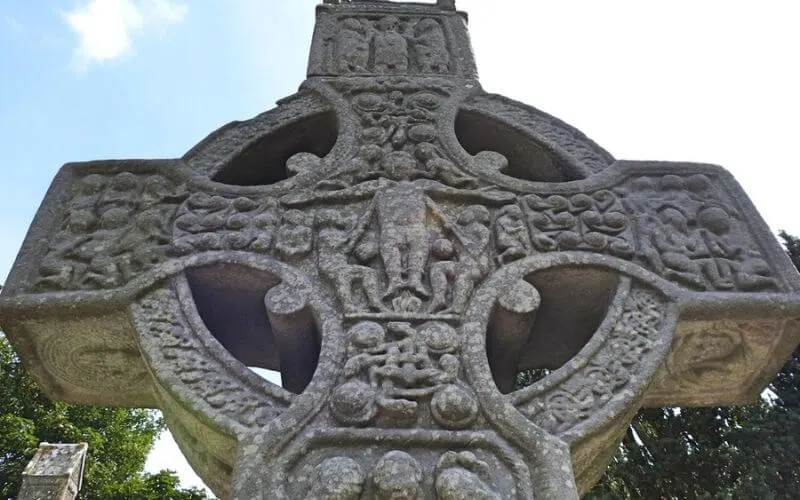
Table of Contents
High Crosses Irish Masterpieces
Some of Ireland’s best artistic masterpieces are almost hiding in plain sight.
Their massive size and elaborate carvings of high crosses are hard to miss in the many ruined monasteries across the country.
However, it is somewhat easy to overlook these impressive stone masterpieces that revolutionized Celtic art and Early Medieval stone carving in Europe.
Often it is the illuminated manuscripts, like the Book of Kells, that receive greater attention and appreciation in terms of Irish art from this period.
High crosses constitute a remarkable feat of engineering and demonstrate incredible skill and ingenuity when it comes to stone carving techniques.
Many of which are over a thousand years old and still don’t fail to impress.
To really grasp how impressive high crosses are, we suggest you should stand next to one to truly appreciate its magnitude and presence!
For more related content, please check out Celtic Crosses, Celtic Symbols, Celtic Knots or Irish Symbols.
What is a High Cross?
A high cross is a stone sculpture in the shape of a Latin cross that usually, but not always, features a ring at the intersection of the arms.
The most striking characteristic of high crosses is their height. These towering monuments stand several meters tall.
For example the West Cross (or aptly named Tall Cross) in Monasterboice, County Louth is the tallest high cross in Ireland measuring about 7 meters (22 ft).
Usually high crosses were made from granite, sandstone or limestone depending on the material available in the locality and the level of detail required for the carving.
(Harder rock types, such as granite, weather better, but are more difficult to carve.)
High Cross Design
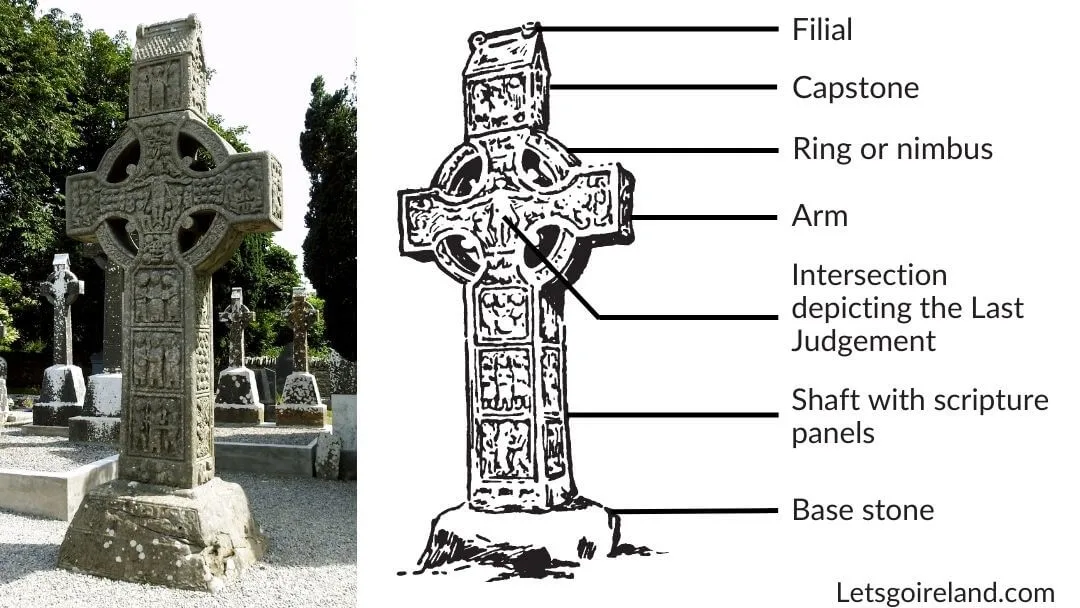
Although all high crosses differ slightly in their design, the main sections can be identified by four characteristic sections.
Base Stone
A large pyramidal base stone with a hollow was usually positioned at the foot of the cross.
This provides structural support in the form of a joint for the vertical beam of the main shaft.
In most cases, the base was embellished with Celtic decoration, or sometimes contained an inscription in the ancient language of ogham.
Ring
High crosses frequently contain a ring (or nimbus), which circles around the four arms towards the top of the cross.
The ring reinforces the arms and helps to stabilize and strengthen the structure.
This is particularly true of the very large high crosses, such as Muiredach’s Cross (Monasterboice, County Louth).
Capstone
At the top of the high cross a capstone is sometimes present.
Over the centuries many of these have been damaged or disappeared completely only showing the joint where one was once fixed in place.
Some of the capstones were shaped like small houses or huts with slanted roofs.
The reason for this is unknown and the high cross house capstone has puzzled many scholars.
One suggestion is that these building-shaped capstones were a leftover design from smaller crosses made of timber or metal in which relics of a saint could be stored in a (possibly detachable) house-shaped reliquary.
However, we may never know the exact reason for sure.
Panels of Carved Celtic Art
One of the most identifiable features of high crosses is the extensive use of carved panels depicting the scriptures using Celtic art imagery and patterns to decorate the entire surface of the cross.
This particular style of art, which included human and animal imagery, as well as geometric patterns and interlace knotwork designs is typical of the Insular art (or Hiberno-Saxon art) of Ireland and Britain from this period.
History of High Crosses
High cross development expanded upon the knowledge and skills previously acquired during the creation of the early Celtic crosses.
(For more in-depth information about Celtic crosses and some Celtic high crosses, you can read our post here.)
Early Irish Celtic Crosses and High Crosses
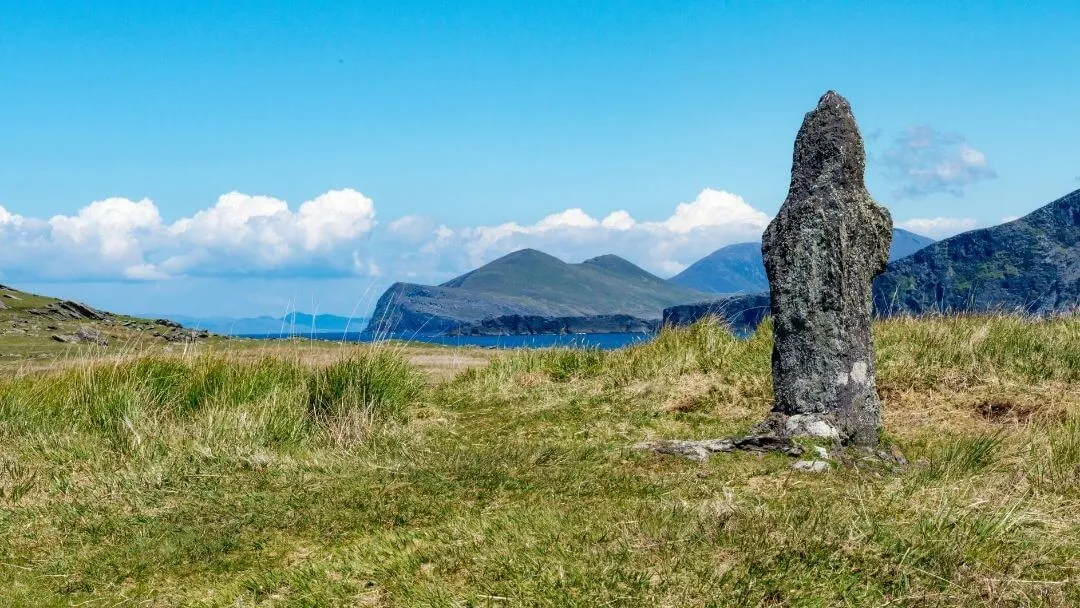
The exact origin of the high cross is hard to pinpoint.
One possibility is that high cross designs originated in Britain, maybe Scotland and that traveling missionaries brought the design idea to Ireland.
It is thought that the oldest high cross in Ireland is located in Carndonagh, County Donegal.
This cross dates back to probably around the 7th century and has a rough cruciform shape.
It differs from the earlier cross slabs, such as Kilvickadownig Cross Slab on the Dingle Peninsula in County Kerry, which had a cross inscribed upon it.
Both figures and Celtic braiding patterns are found on the Carndonagh Cross, but what is noticeably absent is the shape of the ring.
The ring shape is likely to have been introduced at a later point in during the late 8th or early 9th century.
The Ahenny High Crosses in County Tipperary are a good example of Irish high crosses with rings from the 8th century.
Another exceptionally fine example of a high cross from the late 8th century is Kildalton Cross located on the Scottish Isle of Islay.
Golden Age of High Crosses
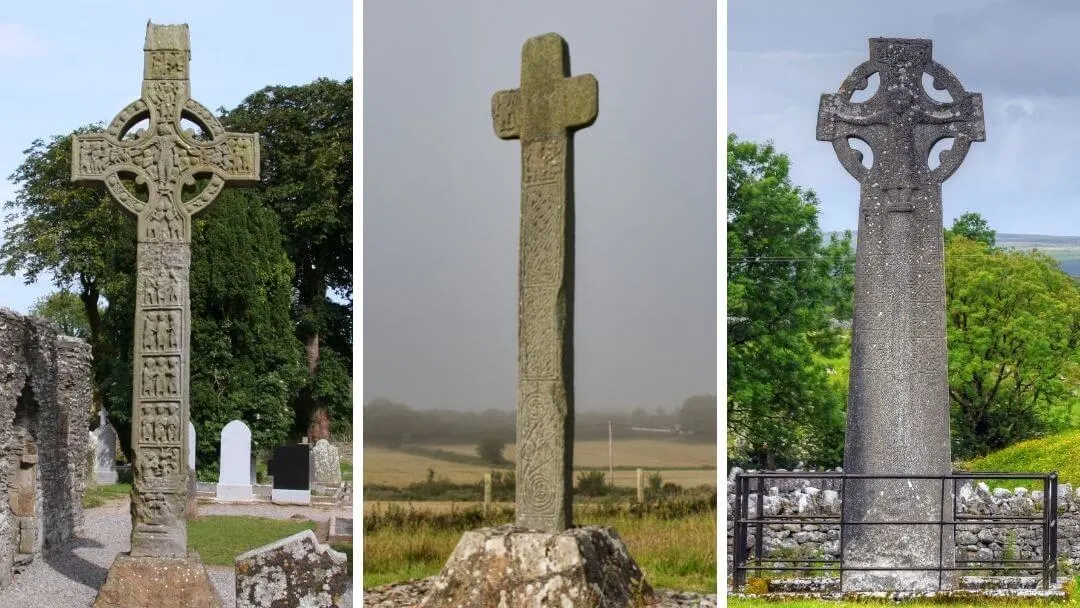
The golden age of high crosses existed from around 800-1150 C.E.
This coincided with the expansion of monastic sites and their respective lay community settlements around the country.
As the monasteries grew in size, importance and power, their political status also increased.
Given the size and scale of these high cross engineering projects, substantial amounts of resources must have been required to bring a project to completion.
This is likely to have led to patronages from wealthy individuals, who in some cases were responsible for commissioning several high crosses.
For example, the Cross of the Scriptures (located in the Clonmacnoise Interpretive Centre, County Offaly) was under the patronage of the High King, Flann Sinna.
During probably the late ninth century, high cross designs started to become bigger and more blocky in their style.
Around this time, the high relief carving of the scripture narratives also became more detailed and greater emphasis was placed on the storytelling aspect and order of the biblical scenes.
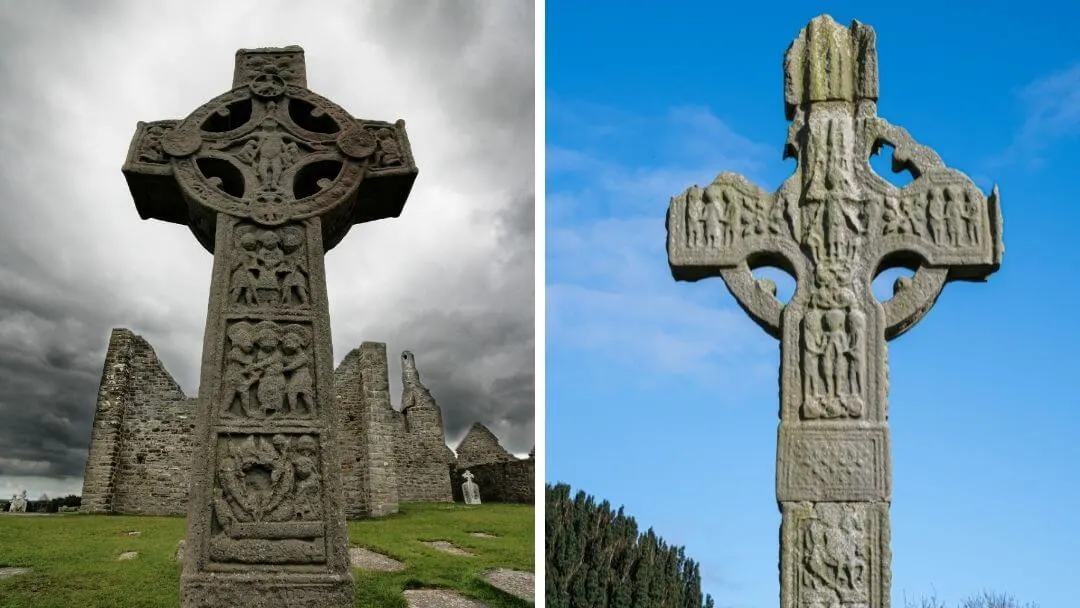
Some of the most impressive of all high crosses date to the late 9th or early 10th century.
It is thought that several of these main high crosses, such as Muiredach’s Cross, the Cross of the Scriptures and the Market Cross of Kells can possibly be attributed to the work of one exceptionally skilled mason, who has been identified as the “Muiredach Master” by the art historian Roger Stalley.
The 11th century appears to have been a relatively quiet time for high cross production, before a resurgence in high cross production in the early 12th century.
This last period of high cross development in Ireland saw a notable influx of Scandinavian influences to the design.
Instead of the chunky, solid designs of previous crosses, the layout of the newer crosses was not as large and as with the earliest high crosses, the ring form is once again often absent.
St. Tola’s Cross at the Monastery of Dysert O’ Dea in County Clare from the 12th century illustrates a completely different style of iconography to the scripture crosses.
Instead of many detailed scenes, the cross displays two high relief figures one on top of each other.
The upper figure showing the Crucification of Christ and the lower figure is that of a bishop, possibly St. Tola the founder of the monastery.
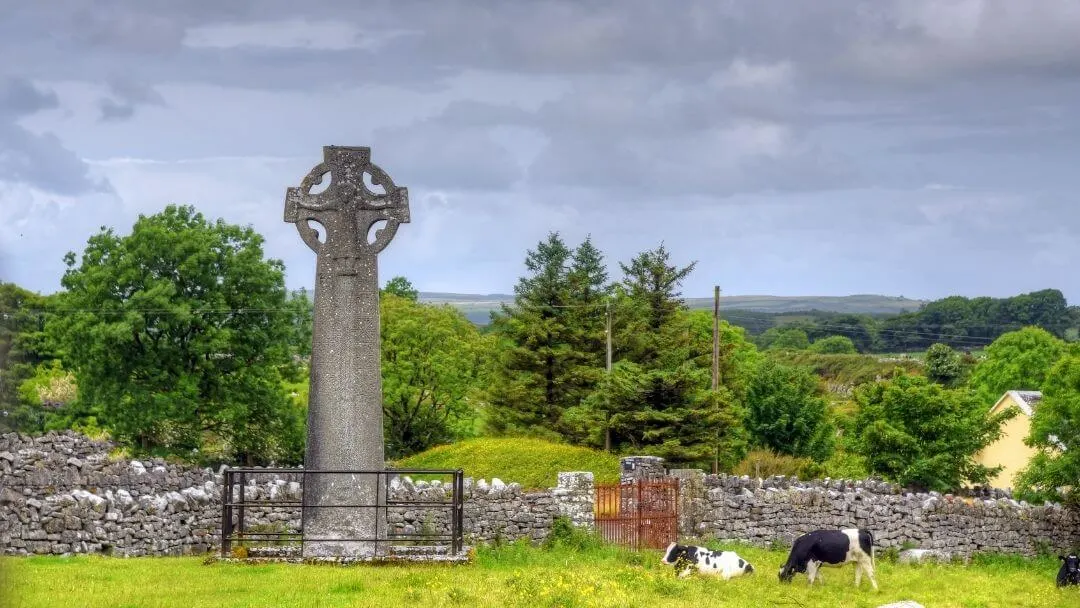
The relatively simple design of the crucifixion on the West Cross in Kilfenora, County Clare dating from about the 12th century, is another typical example from this late high cross period.
After the 12th century, the creation of new high crosses in Ireland ceased almost completely. Some of the Iona high crosses are thought to have been constructed as late as the 14th century.
In the 19th century, brought about a renewed interest in Celtic crosses and in particular high crosses.
One of the most fundamental changes is that after this period was that replica high crosses of reduced size were used as gravemarkers in the form of headstones from this point onwards.
This practice was not used when the high crosses were created.
High Cross Construction
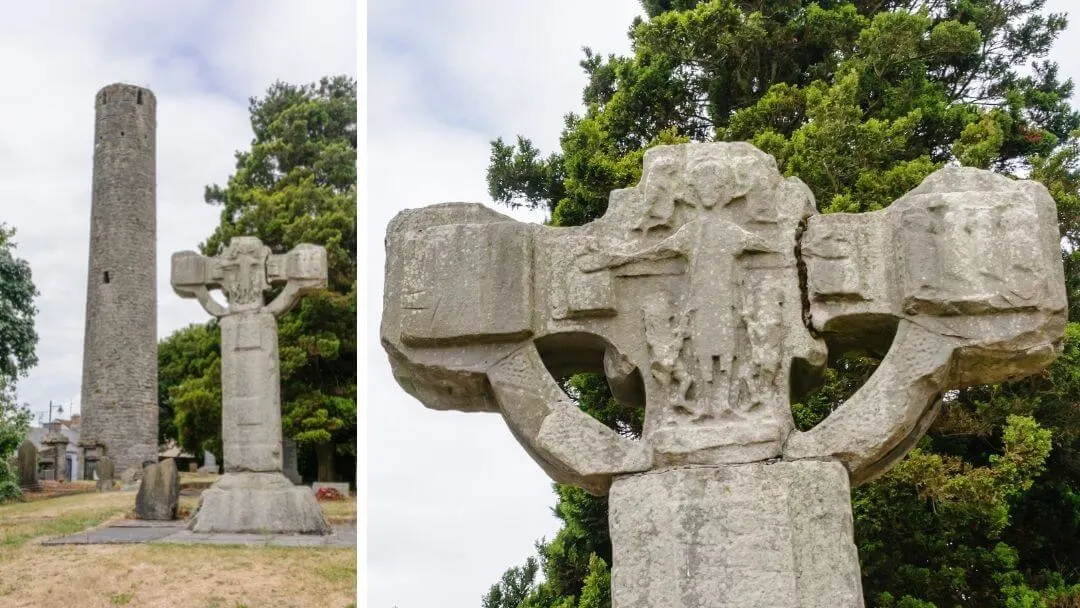
The staggering advancements related to high cross design that took place in a relatively short time frame of a few centuries, identifies Ireland as a major hub of activity.
It is easy to forget the amount of planning and labor that must have gone into constructing such a high cross sculpture.
This was certainly not a quick endeavor and took considerable time and planning to execute.
For example it was first necessary to find suitable stone in relatively close proximity to the future site of the cross.
In the case of Muiredach’s Cross, the stone, which likely weighed as much as 10 tonnes, came from the quarry of Carrickleck about 22 kilometers (ca. 14 miles) away.
There is still quite a bit of debate as to whether the high crosses were carved in situ or prior to their erection.
There was considerable risk to carving the piece before it was erected.
It is difficult to imagine just how some of the pieces could have actually been carved by the expert stonemasons when the cross was free standing.
The East Cross in Kells, County Meath is an example of a half finished cross in situ. Sections of the cross appear to have been prepared for carving as shown in the image above.
Either way, it would have been necessary to use a substantial hoist system to maneuver the extremely heavy upper sections of the cross into place.
Muiredach Master
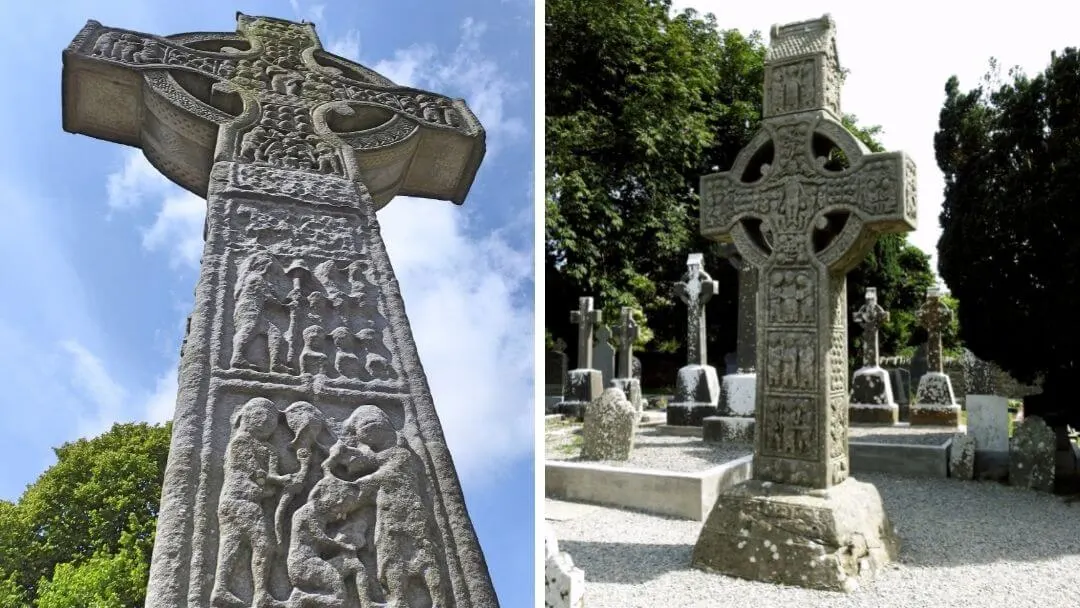
One of the most intriguing parts of the history of the high cross development is the master stonemason, the so-called “Muiredach master”.
This master was responsible for creating some of the most impressive pieces of Early Medieval stone carving in Europe.
As there are no written records about these high crosses, scholars are left to discover clues about the creators from the surviving artwork.
Stonemasons would have a selection of tool options to create the desired effect on the stone such as axes, chisels and even drills.
The very clear distinctive style of the figures on the crosses of the Market Cross of Kells, Cross of the Scriptures and Durrow High Cross act like a signature for this particular mastermind stonemason (or perhaps a school of stonemasons).
As word spread about the exquisite stonemason skills, it is likely that other wealthy and influential individuals commissioned other high crosses.
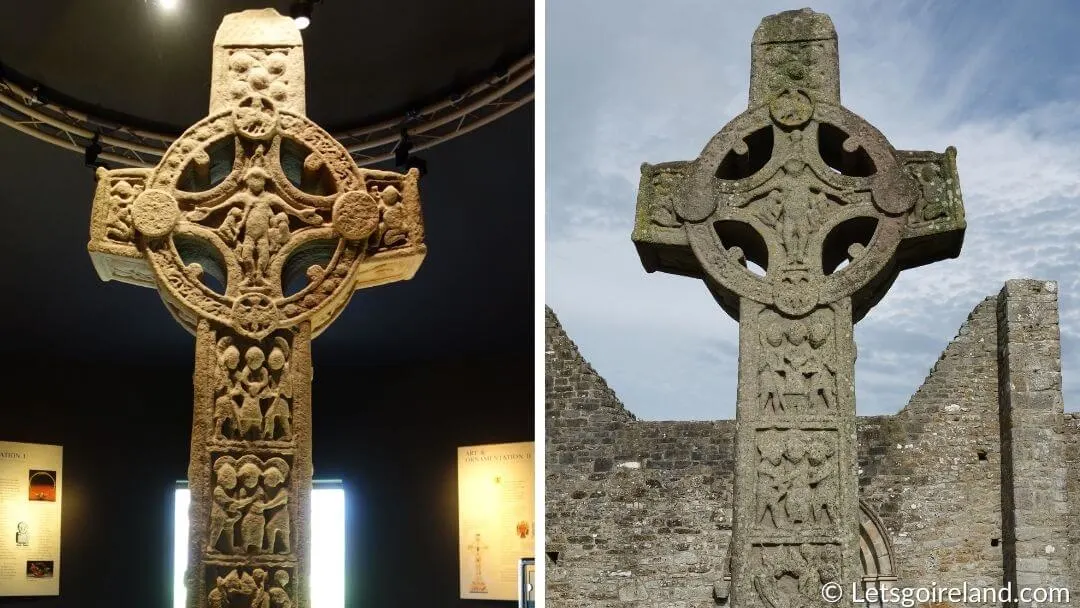
What was the Purpose of High Crosses?
High crosses most likely fulfilled several functions.
The detailed scripture panels functioned as an educational tool for biblical stories.
In addition, many high crosses also served as status symbols for prominent abbots or kings, while in other cases they acted as boundary markers (termon crosses).
High Crosses as an Educational Tool
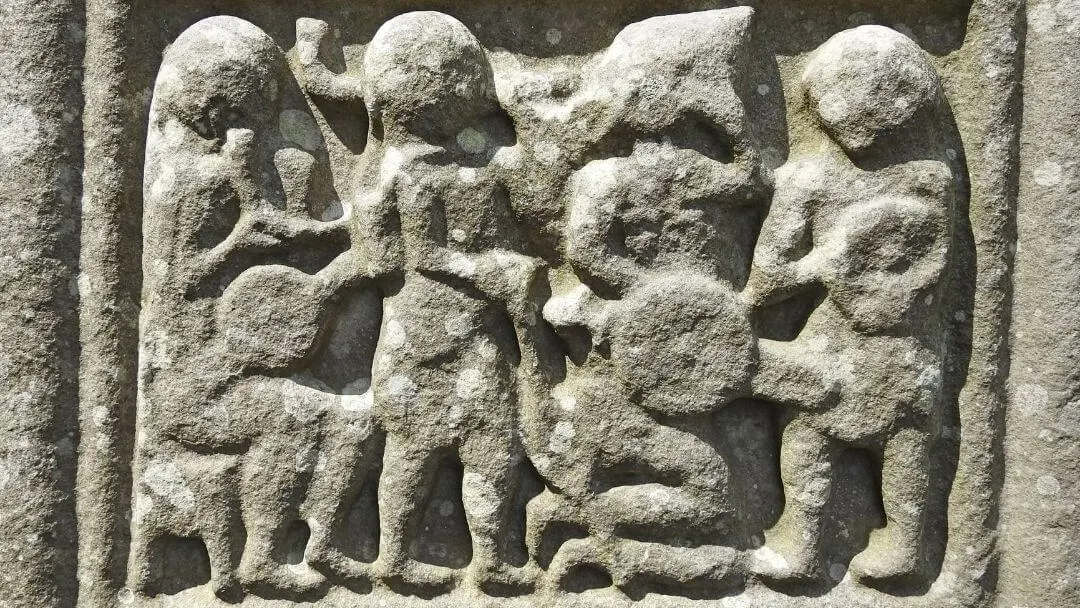
First impressions may lead one to think of the significance of high crosses in a mainly religious context, however the functions are likely to be more broad than this.
For example, it is unlikely that the primary function of these high crosses was to educate people through the elaborate biblical scenes.
The carefully selected scenes from the Old Testament and New Testament were most likely aimed at a knowledgeable audience.
It is quite likely that the crosses were even painted to make the carvings even more vibrant.
What is clear is that high crosses were definitely designed to impress.
Given that many of these high crosses are more than one thousand years old and still inspire great awe and wonder today, gives an inkling of how extraordinary they must have been to the people living when they were first constructed.
Celtic Crosses as Status Symbols
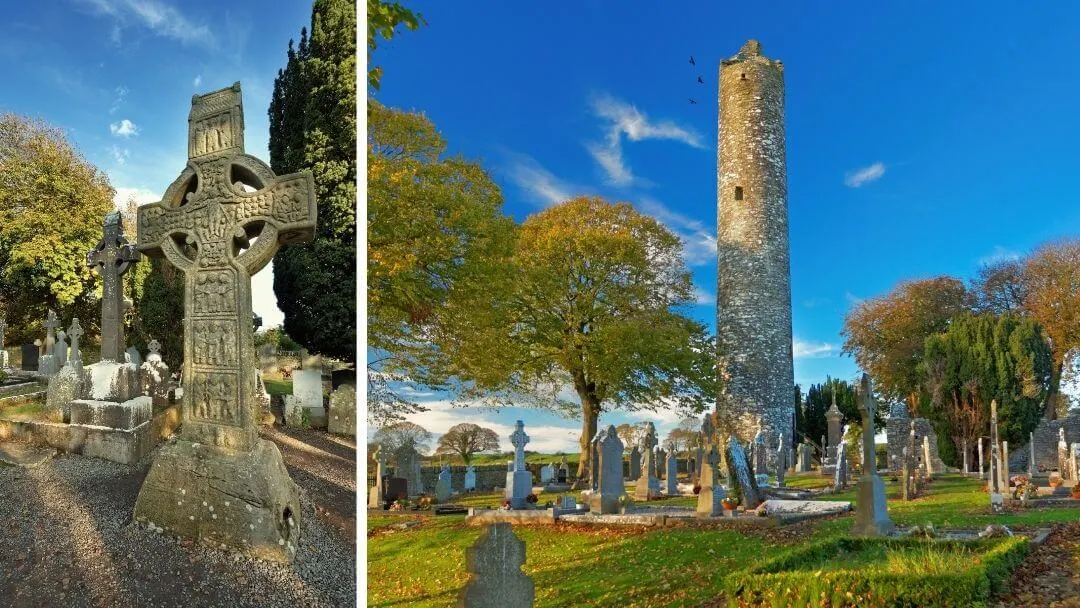
This supports the idea that at least some high crosses were used as a symbol of status and power and perhaps to also leave a lasting legacy.
Muiredach Cross has an inscription which translates to “a prayer for Muiredach who had this cross made” and is thought to refer to the abbot of the monastery.
As the inscription has been written around two cat carvings, it may have been added after the cross was completed.
Celtic Crosses as Boundary Markers
Other functions of high crosses include marking boundary lines.
The Castlekeeran high crosses in County Meath are examples of these boundary crosses (also known as termon crosses) and are relatively planly carved.
Famous High Crosses in Ireland
Early Irish Celtic crosses paved the way for the more elaborate designs of the high crosses that followed.
There are crosses scattered all over Ireland, so it is difficult to select just a few ones to highlight.
Here are a few of the most stunning examples.
Ahenny High Crosses, County Tipperary
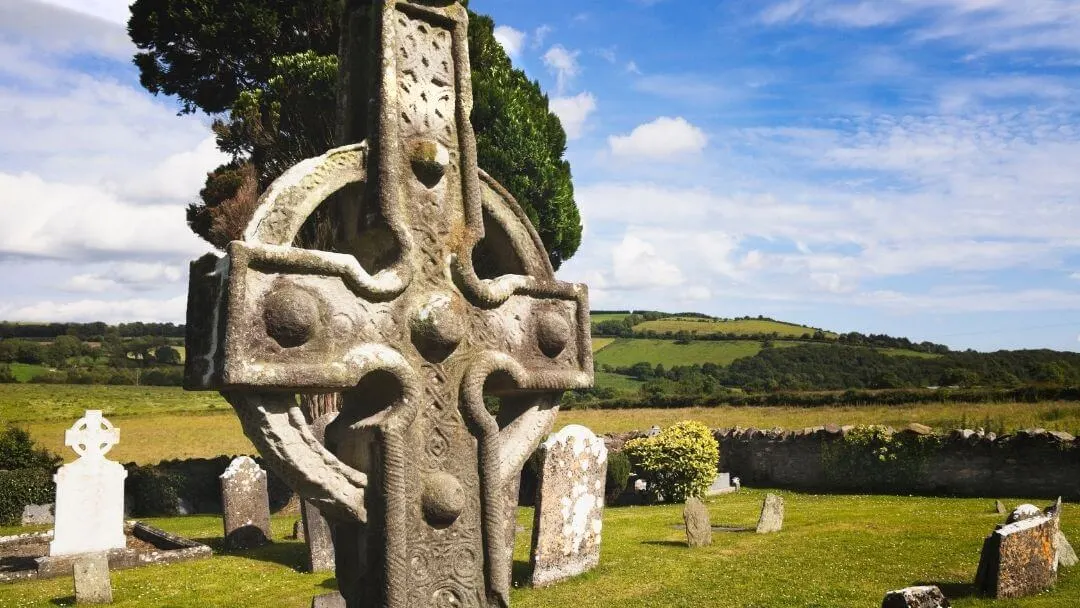
Some of the earliest stone crosses are part of the Ossory group of crosses that were once part of the Kingdom of Ossory.
The Ahenny High Crosses are two crosses from this group at the monastic site of Kilclispeen in County Tipperary.
They are thought to have been constructed in the 8th century
What makes these crosses unique is that they are based on the design of wooden crosses that previously existed at the site.
These wooden crosses were enclosed in metal cases featuring ornate Celtic designs of spirals and interlacing.
The original patterns of the metalwork and bosses were then replicated in the stone carving of the crosses. Only the base stones feature figure carvings.
At some point in the past, the North Cross (ca. 3.1 m or 10 ft) lost one of the connecting ring sections and so the ring is no longer complete. The South Cross is slightly larger at 3.9 meters (12.7 ft).
The Celtic knotwork patterns of the Ahenny Crosses have served as inspiration for the modern version of the Celtic cross that has been popular since the Celtic revival.
Muirdeach’s Cross, County Louth
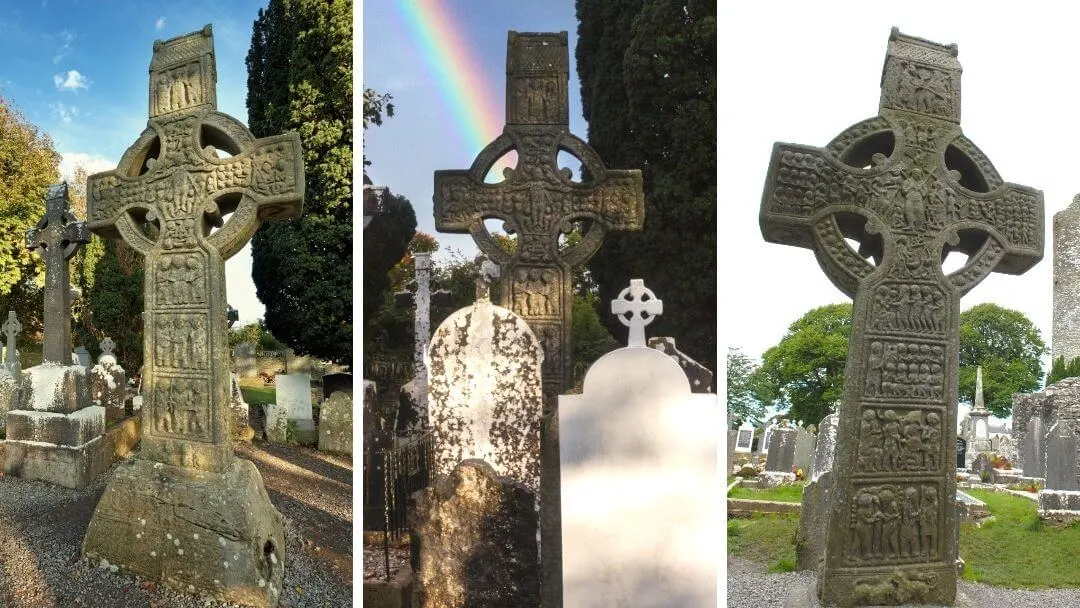
Muiredach’s Cross is one of the most impressive of all of the Irish high crosses. Scholars believe that this sandstone cross was most likely made after 850 C.E., but probably no later than around 920 C.E.
The high relief panels which cover each side of the cross contain detailed biblical scenes.
These include Adam and Eve, the Adoration of the Magi and the Ascension.
The central section on the west face illustrates the crucifixion, while the Last Judgement is carved on the central area of the east face.
Animal imagery carvings of cats, snakes and even centaurs can also be found in the iconography.
Muiredach’s Cross is the most famous Monasterboice cross, but there are two other high crosses on the site of the monastic ruins.
The other crosses are called the West Cross and the less decorated, North Cross.
In addition to the two churches on site, there is also a round tower, which was used to shelter the monks and precious artifacts from the Viking raids.
Kells High Crosses
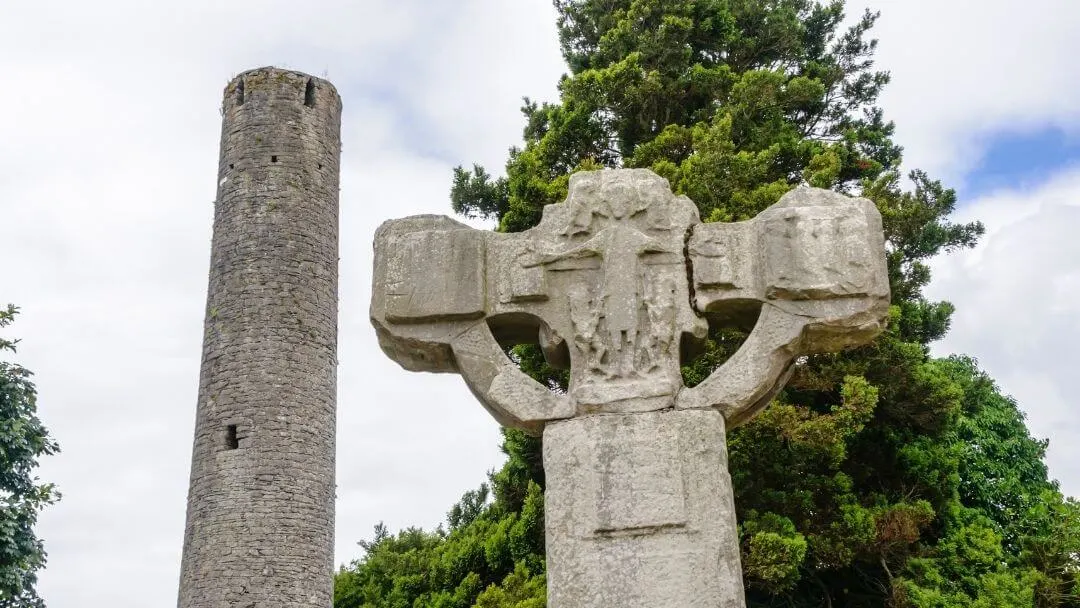
Kells in County Meath is not only famed for its association with the illuminated manuscript, the Book of Kells, which is now on exhibit in Trinity College Dublin, the town is also home to a collection of five high crosses:
- The Market Cross
- The West Cross
- The East Cross
- The Cross of St. Patrick and St. Columba
- The North Cross (only the base remains)
The Market Cross, thought to date to have been constructed around the same time as the Muiredach’s Cross and possibly by the same stonemasons, is the most famous of these crosses.
It stood in the shop market square of Kells, until it was damaged by a school bus in 1996.
Now it can be viewed under a protective shelter outside the former courthouse in the town.
Some sections of this cross are badly weathered and it is missing the uppermost arm, but it is still possible to see the detailed iconography including Daniel in the Lions Den, Cain and Abel and several hunting scenes.
One section of iconography was removed during the 17th century and an inscription was added.
High Cross of Moone
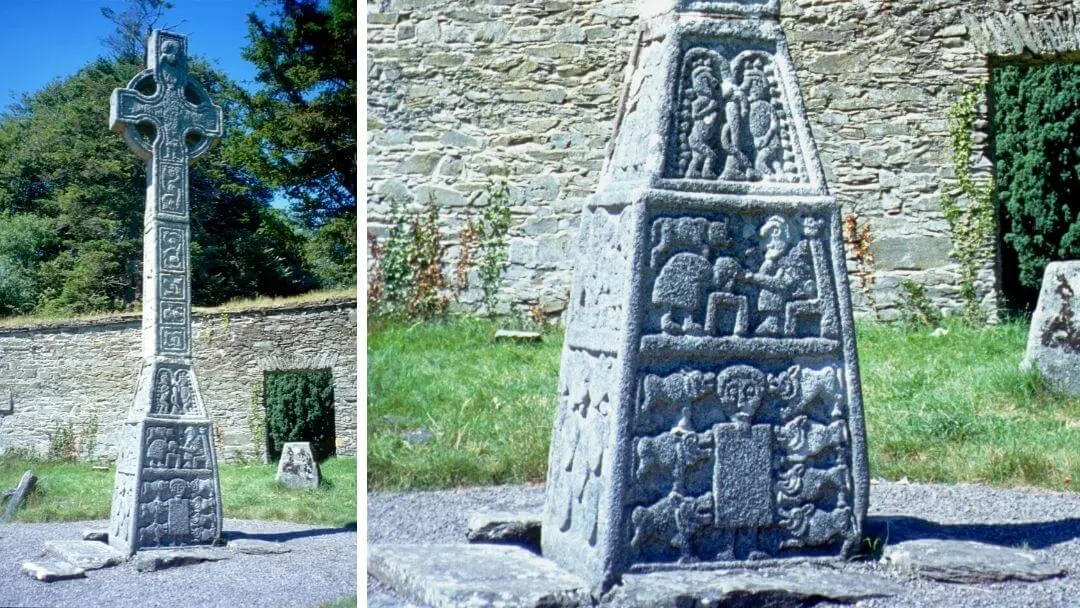
The High Cross of Moone in County Kildare, differs from the stockier design of Muiredach’s Cross and that of the Market Cross of Kells.
Instead it is particularly lean and slender in design and is thought to be the second tallest high cross in Ireland (ca. 7 meters).
It was constructed from granite and the cross features scripture scenes illustrating God helping people such as the miracle of the loaves and the fishes and shielding the innocents from danger.
The base and top sections of this high cross were first rediscovered in the early 19th century.
Later the main shaft was uncovered and now the complete cross has been reassembled and relatively recently restored.
Irish Crosses
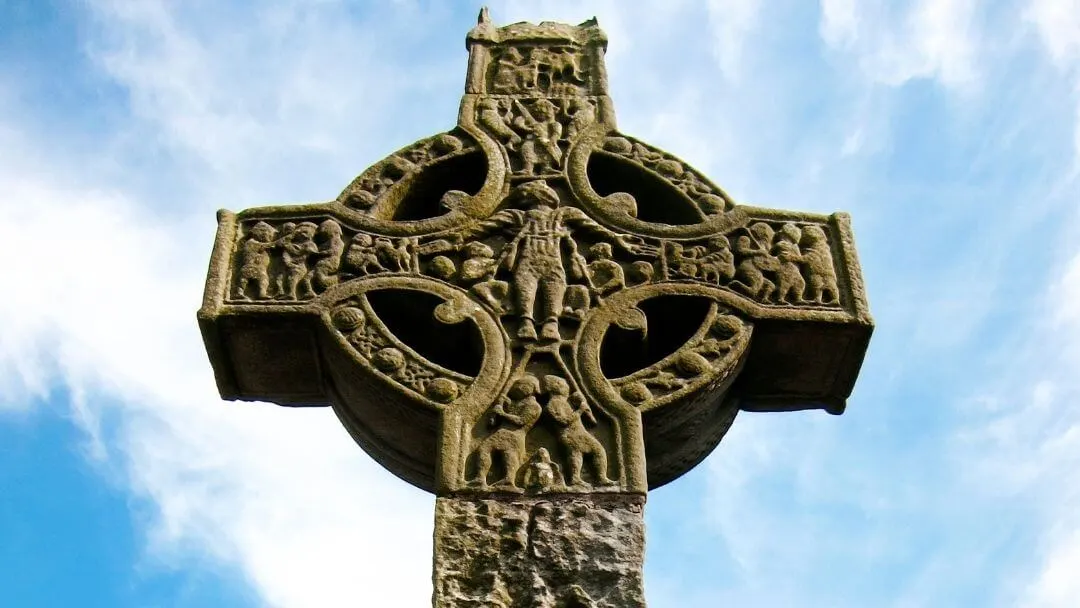
High crosses (and to a possibly lesser extent Saint Brigid’s Crosses) have provided inspiration for many pieces of Irish jewelry and home decor.
Modern Celtic cross designs are often based on early and late period high crosses that were decorated with the Celtic knot artwork of triskeles, spirals and Trinity knot patterns.
(For example, patterns similar to the artwork found on the Ahenny High Crosses).
In terms of Celtic jewelry, sterling silver or gold Celtic cross pendants can be a particularly striking feature piece.
Irish Celtic cross jewelry in the form of rings and earrings are also popular choices.
For more insights into Irish jewelry, take a look at our post about Claddagh rings and their meaning.
Irish Celtic wall crosses carved from Connemara marble or timber, or created from porcelain (such as Belleek) are still found in some of the houses of mainly the older generations in Ireland.
Some Irish wall crosses located near the main door contain a holy water font and would have been used as part of short prayer upon entering or leaving a house.
For more interesting articles on similar topics why not check out Celtic Crosses, Celtic Symbols, Celtic Knots or Irish Symbols.
This post may contain affiliate links.If you click on one of them, we might receive a small commission (at no extra cost to you). Thank you for your support.
